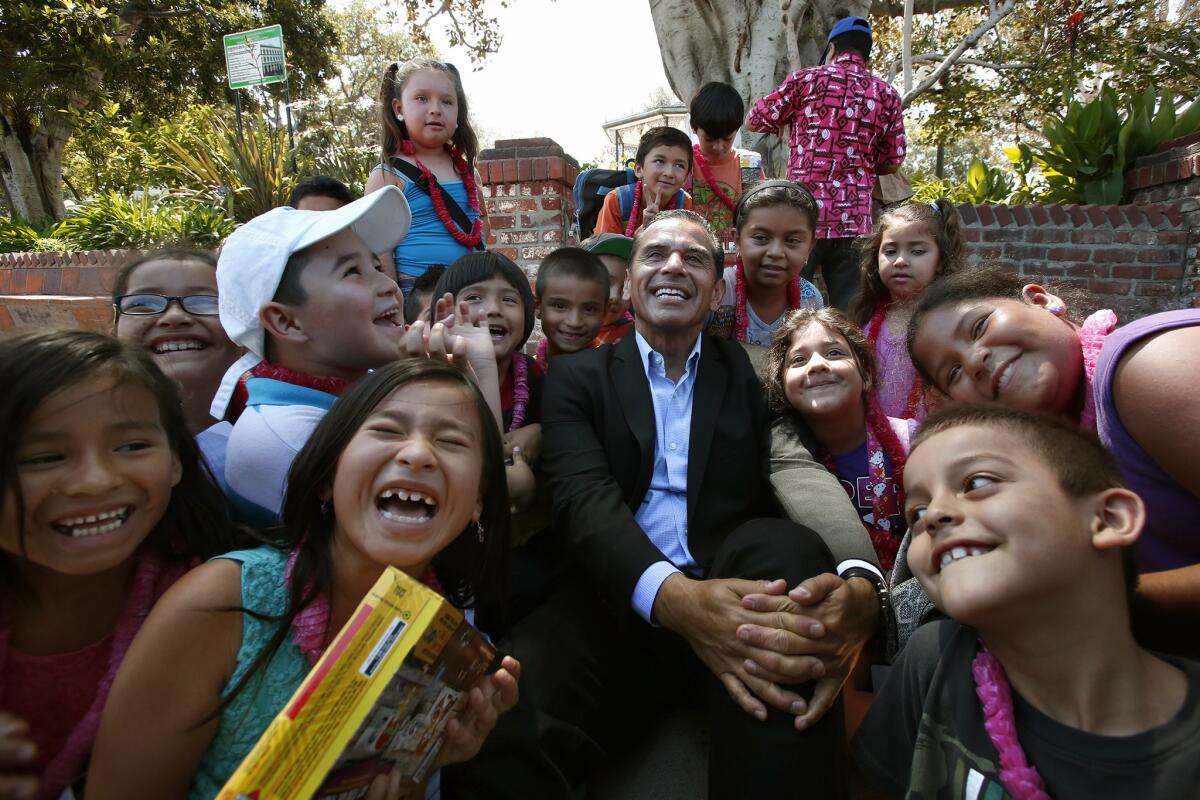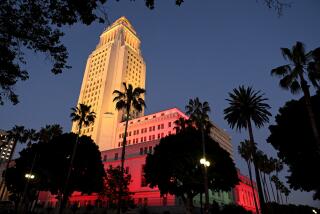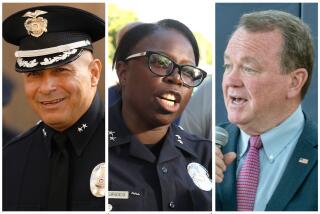Villaraigosa leaves a legacy of thinking big

- Share via
On his first day as mayor, Antonio Villaraigosa told Los Angeles that it was time to “start thinking big again.”
New public transit spending could make Los Angeles’ bus and rail network worthy of a great metropolis. A bigger police force could make neighborhoods safer. Renewable energy projects could turn Los Angeles into America’s “greenest big city.” Public school reforms could reverse decades of decline.
Eight years after sharing that vision in his first inaugural address, Villaraigosa has achieved much of what he set out to accomplish.
Rail stations under construction on the traffic-clogged Westside attest to the billions of dollars in transit money he secured. Los Angeles hired hundreds of new police officers. Violent crime plummeted.
And the Department of Water and Power established itself as a leader among utilities nationwide in shifting from coal-fired power plants to solar and wind energy.
Villaraigosa, whose mayoralty ends Sunday, fell short in some areas. His inability to gain control of the L.A. Unified School District stands out, even though he has wielded clout through Board of Education allies at a time of academic gains.
The city’s fiscal condition, ravaged by the economic downturn, has improved, but remains shaky, due partly to raises that Villaraigosa approved for city workers just before the recession. Chronic troubles with the Fire Department’s emergency response time have also tarnished his record.
Reflecting on his two terms in a recent interview at his City Hall office, Villaraigosa, 60, recalled that his breakthrough as the first Latino mayor of modern Los Angeles was once the main focus of conversation about him. He said he was proud it no longer is.
“Almost nobody in this town describes me as the Latino mayor,” he said. “I love that.”
In a city under the firm grip of conservative white political forces until 1973, when Tom Bradley became its first black mayor, Villaraigosa’s 2005 victory symbolized the ascendance of Latinos and the Southern California labor movement.
Villaraigosa took office amid rapid changes in the urban landscape of Los Angeles, most dramatically in the revival of downtown and Hollywood. He embraced those changes and tried to hasten the city’s transformation into a place that is more amenable to pedestrians, cyclists and public transit passengers. The city opened 149 miles of bike lanes and launched CicLAvia, a festive cycling event along miles of boulevards closed to auto traffic for the day.
By lucky timing, large-scale rail investments by his predecessors came to fruition on Villaraigosa’s watch. The Gold Line between Union Station and East L.A. opened, followed by the Expo Line linking downtown and Culver City.
But Villaraigosa made his own mark by leading the campaign for Measure R, a $35-billion transportation package passed by voters in 2008. Largely through that ballot measure, Villaraigosa reshaped the region’s notoriously inefficient transit system more than any mayor since Bradley, who got a subway line built between downtown and North Hollywood. Measure R produced much of the money now being spent to extend the Expo Line into Santa Monica, start construction on the new Crenshaw Line in South Los Angeles and bring the Wilshire Boulevard subway to the Westside. It also covers an array of other rail, bus and road projects across Los Angeles County, some of them coupled with zoning changes to concentrate new development around transit stops and draw people out of their cars.
“One of the things about Villaraigosa that is most impressive is that he actually did get it done, and the importance of Measure R cannot be overstated,” said Martin Wachs, an urban planning expert at the Rand Corp.
Although Wachs doubts the potential for traffic relief, he described the combination of transit spending and the downtown resurgence as a major advance in lifting Los Angeles into the top ranks of world capitals. “Los Angeles is transforming from one kind of city into another,” he said.
The transit projects, like Villaraigosa’s agenda to fight crime and pollution, came with a cost. Measure R imposed a countywide half-cent sales tax increase until 2039. To pay for the police force expansion, the city tripled residential trash fees. Electricity rates, driven partly by his renewable energy spending, have risen 33% under Villaraigosa.
Stuart Waldman, president of the Valley Industry & Commerce Assn., said the mayor had not tried hard enough to limit DWP rate increases while making the transition from fossil fuels to more costly renewable power. Los Angeles has long had relatively low power rates. “I think it’s great that we’re doing all these measures to bring in solar and reduce our dependence on coal, but at the end of the day, businesses look at their bottom line,” Waldman said.
Environmentalists welcomed the utility’s growing reliance on renewables, along with the drop in truck pollution at the Los Angeles Harbor, synchronization of city traffic lights and installation of energy-saving LEDs in city streetlights. Evan Gillespie, a deputy director of the Sierra Club’s Beyond Coal Campaign, called Villaraigosa’s record “phenomenal,” particularly in addressing climate change. “We now have a road map from the largest public utility in the nation for how you rapidly cut carbon pollution,” he said.
On crime, experts debate whether Villaraigosa’s police hiring had any direct impact. Either way, the violent crime reduction has improved the quality of life in many neighborhoods. In the Florence section of South Los Angeles, three people were killed last year, down from 20 in 2007. Boyle Heights had 13 homicides last year, a drop from 23 in 2007.
Also significant was the consolidation of police reform. With its history of abuse and unaccountability, the LAPD was long seen as “an occupying army -- certainly in the African American community,” said Raphael J. Sonenshein, the author of “Politics in Black and White: Race and Power in Los Angeles.”
Villaraigosa’s police chiefs, first William J. Bratton and now Charlie Beck, guided the department to its exit from a consent decree that imposed federal court oversight of reforms required by the Justice Department after the Rampart corruption scandal.
“He really maintained the momentum of police reform, and that’s no easy thing,” Sonenshein said.
More broadly, Sonenshein gave credit to Villaraigosa, a former state Assembly speaker, for his political agility. It enabled him, among other things, to push the trash fee increase through the City Council for police hiring and win voter approval of the Measure R transit windfall.
“With Villaraigosa, what you see is maybe the most skilled politician of all the mayors of modern times,” he said.
Steven P. Erie, the author of “Globalizing L.A.,” said it was too early to say whether Villaraigosa had succeeded in matching Bradley’s legacy as “the last mayor to fundamentally change the face of Los Angeles.”
“It’s a long process,” Erie said, “to clean up a town that basically worshiped growth and was willing to pay the price.”
Times staff writers Howard Blume, Ben Welsh and David Zahniser contributed to this report.
More to Read
Sign up for Essential California
The most important California stories and recommendations in your inbox every morning.
You may occasionally receive promotional content from the Los Angeles Times.











